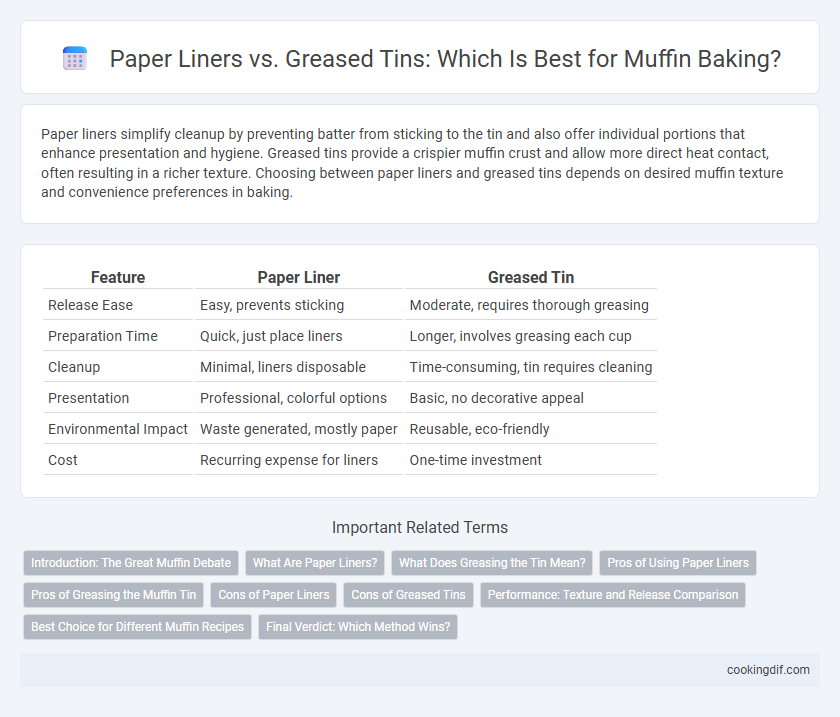Paper liners simplify cleanup by preventing batter from sticking to the tin and also offer individual portions that enhance presentation and hygiene. Greased tins provide a crispier muffin crust and allow more direct heat contact, often resulting in a richer texture. Choosing between paper liners and greased tins depends on desired muffin texture and convenience preferences in baking.
Table of Comparison
| Feature | Paper Liner | Greased Tin |
|---|---|---|
| Release Ease | Easy, prevents sticking | Moderate, requires thorough greasing |
| Preparation Time | Quick, just place liners | Longer, involves greasing each cup |
| Cleanup | Minimal, liners disposable | Time-consuming, tin requires cleaning |
| Presentation | Professional, colorful options | Basic, no decorative appeal |
| Environmental Impact | Waste generated, mostly paper | Reusable, eco-friendly |
| Cost | Recurring expense for liners | One-time investment |
Introduction: The Great Muffin Debate
Paper liners provide convenience and easy cleanup by preventing muffins from sticking, maintaining moistness, and offering hygienic benefits. Greased tins can yield crisper edges and more uniform browning, but require thorough greasing to avoid sticking and can be less convenient when removing muffins. The choice between paper liners and greased tins depends on desired texture, ease of use, and presentation preferences in muffin baking.
What Are Paper Liners?
Paper liners are thin, disposable cups made from food-grade paper designed to fit inside muffin tins, providing a non-stick surface that simplifies the removal of baked muffins and reduces cleanup. They come in various sizes and colors, allowing for easy portion control and decorative appeal while helping to retain moisture and prevent muffins from sticking to the pan. Using paper liners can improve muffin presentation and hygiene, making them a popular choice for both home bakers and commercial bakeries.
What Does Greasing the Tin Mean?
Greasing the tin means coating the baking pan with butter, oil, or cooking spray to create a non-stick surface that prevents muffins from sticking during baking. This method ensures even browning and easy removal, especially when not using paper liners. While paper liners provide convenience and less cleanup, greasing the tin offers a traditional approach that can enhance muffin texture and crust formation.
Pros of Using Paper Liners
Paper liners prevent muffins from sticking to the tin, ensuring easy removal and maintaining the muffin's shape. They also reduce cleanup time by protecting baking tins from grease and crumbs. Additionally, paper liners enhance presentation, offering an attractive, hygienic way to serve muffins.
Pros of Greasing the Muffin Tin
Greasing the muffin tin creates a thin, even non-stick layer that allows muffins to develop a crisp, caramelized crust, enhancing texture and flavor. It enables easy release of muffins without tearing or residue, preserving the visual appeal and structural integrity of each baked good. Greased tins promote even baking by allowing heat to conduct directly to the batter's surface, resulting in consistent, golden-brown muffins.
Cons of Paper Liners
Paper liners can sometimes trap moisture, leading to soggy muffin bottoms and less crispy edges. They may also cause uneven baking by preventing direct heat contact with the muffin tin, resulting in inconsistent texture. Additionally, removing liners can occasionally cause muffin tops to tear, compromising presentation and serving quality.
Cons of Greased Tins
Greased tins often cause muffins to have uneven surfaces due to inconsistent oil application, leading to sticking and difficult removal. Excess grease can result in soggy muffin edges and compromised texture, reducing overall quality. Cleaning greased tins is more labor-intensive compared to using disposable paper liners, making the baking process less efficient.
Performance: Texture and Release Comparison
Paper liners provide consistent moisture retention, resulting in a tender crumb and even baking, while also ensuring easy release without sticking or damaging the muffin's texture. Greased tins offer a slightly crisper edge due to direct contact with the metal but can sometimes cause uneven browning and require careful greasing to prevent sticking, which may affect the muffin's surface texture. Overall, paper liners enhance both texture uniformity and clean release, making them preferable for delicate muffin varieties.
Best Choice for Different Muffin Recipes
Paper liners offer convenience and easy cleanup, making them ideal for delicate or moist muffin recipes that might stick to the pan. Greased tins provide a crispier crust and are preferred for recipes with denser batter or when a golden exterior is desired. Choosing between paper liners and greased tins depends on the muffin's moisture content and texture preferences, with liners preserving softness and tins enhancing crust formation.
Final Verdict: Which Method Wins?
Paper liners provide cleaner presentation and easier cleanup, maintaining muffin shape while preventing sticking, making them ideal for delicate or moist batters. Greased tins promote better browning and crust formation, offering slight textural advantages but require more thorough cleaning and can cause muffins to stick if not properly greased. Overall, paper liners win for convenience and aesthetic appeal, while greased tins suit those prioritizing texture and crust quality in muffin baking.
Paper liner vs greased tin for muffin baking Infographic

 cookingdif.com
cookingdif.com